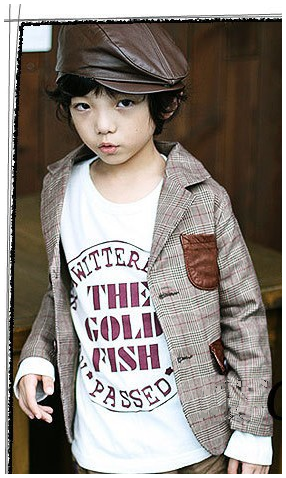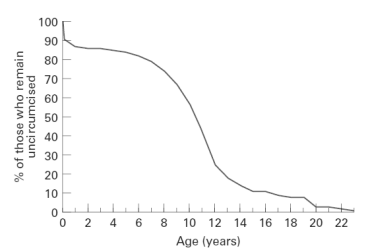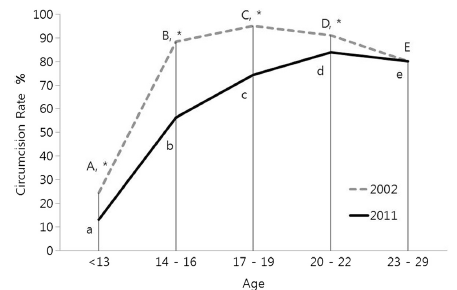 Korea
Korea
The Whale Hunt

Now that the winter vacation is over, elementary schools are once again filled with the
excited chatter and laughter of children. Many of the children talk about ski trips and
vacations with their parents, but not all of them are chattering about the joys of
youth. Many of the boy students have returned to school as veterans of the "whale hunt,"
and in somewhat excited voices relate their experience to their fellow male classmates
and juniors. What is the "whale hunt"? The word "whale hunt" in Korean is the same word as foreskin, and it has become a clever way for young Korean males to express
circumcision.
In Korea, circumcision is generally done between the ages of 9-14. Why
do Koreans do it so late, and why in the winter? According to a report done by
Robert T. Francoeur and Yi Hu-so:
"In the 1960s, Korean doctors and advice columnists launched a campaign
in newspapers and magazines urging parents to have their adolescent sons
circumcised during the long winter break before a boy enters middle
school. Infections, the Korean doctors say, are much less likely if
circumcision is done in the winter rather than in the summer."
(Having a long break to recover before going back to school is probably also a relevant issue. Ed)
Korea is an extremely socially oriented country -- everyone must fit in. Those who
are different or do not fit society's norms are often made into pariahs, and thus it is
not unreasonable to understand the group mentality in being circumcised (young boys
often go with their friends as a small group to be circumcised) and the embarrassment
of those who are uncircumcised.
According to several studies, the vast majority of Korean men are circumcised. "Today, at least 95 percent of South Korean boys entering middle school have had been circumcised. For the other five percent, the question is not whether they should give up their foreskin, but when they should be circumcised."
Extracts from "The 'Whale Hunt" by Robert Neff. [1]
Image from an advertisement by Korean clothing company ISSOkids. No specific connection with circumcision is intended.
The Republic of Korea ia a nation of about 50 million people occupying the southern half of the Korean Peninsula, but claiming sovereignty over the entire peninsula. The northern half - Democratic People's Republic of Korea - makes the same claim, and the two are nominally at war, but in practice a fragile truce has reigned for over 60 years, and both are now separate members of the United Nations. However the Republic of Korea (South Korea) is now a major world economy, and the north is a secretive backwater.
South Korea has the world's highest rate of non-religious circumcision, exceeding even the United States. Little is known aboout circumcision in the North, but the rate is believed to be low. This article is primarily about the South, but if anyone can supply information about the North it is welcome, and will be included.
Map courtesy of printable-maps.blogspot.com
|
 |
A Korean Mother's Report
Mass Circumcisions at Schools
In the past, more than a couple decades ago from now, some schools would have mass circumcisions of multiple boys. Circumcision rate in Korea was higher in the past, and mass circumcisions at schools were thought to be promoting public health by ensuring that multiple boys get the cut at no or little cost to their parents. Schools in Korea still do things like mass vaccinations or mass blood tests of the students, but no longer the mass circ. I don’t know how this may sound like in other countries, but Korea is such a collectivist country, and it was even more so in the past.
I personally didn’t attend a school that did mass circs when I was a schoolgirl, but I heard of the experience from my friends. They say that the boys were lined up to be cut at the medical room inside the school, all of them with faces like they were about to enter the gas chamber. I can see how mass circs at schools would promote public health, but I think it would have also been an interesting site to see. Oh, those poor nervous boys!

Circ and Coming of Age
Because the circs in Korea happen at later ages than in the US where most circs are done on newborns, circ has a meaning of coming of age in Korea. Many boys in Korea get the cut in later elementary school years or early middle school years, roughly coinciding with the start of adolescence. As a mother of two boys, I’ve heard from other moms that some of their boys want to be circumcised sooner so that their penis would look like a grown-up’s penis than a boy’s. In the past, when the circ rate was higher, some boys who are still uncut would be teased at places like school bathrooms for their “turtlenecks.” 
Also, because the boys getting the cut in Korea tend to be much older than newborns, the circ is viewed a little differently. For instance, the boys of the applicable age would sometimes talk about circs and ask how it was if a friend of them recently got the cut. They wonder whether it hurt and was it embarrassing to be naked in front of the female nurses, etc. When I was a kid, I remember some boys saying that one of them in their clique recently got the cut. I didn’t quite know what they were talking about back then, but I remember the mood of the boys sinking a little. It was most likely because of the boys still with their foreskins getting a little nervous about their impending fate, to be cut like their friend. (Now, I find it rather cute when the boys talk about circs in a worried tone.)
The boy is advertising 'a jumper for spring and autumn 2015'.
Mothers’ Influence on Circs
Although mothers, as women, don’t have the body part to experience circs, it’s usually the mothers who get more involved with their sons’ cut than the fathers from my experience. I remember when I took my two sons to the clinic to get them snipped, it was mostly other mothers who brought their sons to the clinic, not fathers. Also, when I get together with other kids’ mothers, we sometimes talk about circs like to get it done or not, how much it would hurt, etc. I think the Confucian culture of women rearing the kids and tending to the family while the men work has to do with the tendency of mothers usually taking care of the sons’ circs, not fathers.
Additionally, as your website correctly points out, many circs in Korea are done in the winter. I remember telling other moms about an ad I saw in one winter. It was a clinic promoting a discount for the circ in the winter to get a higher number of boys needing the cut during the winter break. We all had a good laugh! Truth be told, when it’s near winter break, some boys worry whether their foreskins would survive the break because it’s the season when mothers take their sons to the clinics for the cut. I know my sons’ foreskins got the cut during the winter.
Sex Education about Circumcision to Adolescent Kids
Again, because circs in Korea happen roughly at the ages when adolescence starts, sex education materials at schools or regular books would teach about circumcision to the kids. When I was growing up, the sex education materials for adolescent kids would say that boys need to be cut for better hygiene, but with the declining circ rates these days, the sex education materials now don’t go as far as recommending circs.
Circ makes better Lovers?
In Korea, for some reason, there’s a myth that circs can turn a male into a better lover. I can understand circ enhancing hygiene, but this myth goes further, saying that a penis would get bigger if circumcised or that the male would last longer thanks to the cut. The story about the size has to do with some people thinking that when a penis is uncut, the foreskin is constantly exerting a low pressure on the glans, preventing it from growing. According to this theory, the circ helps the penis to grow by getting rid of the foreskin that’s pressing down on it. Thus, some mothers would get their sons cut sooner so that they don’t end up with a small penis. (I know it might be a little creepy to hear about mothers worrying about their sons’ penis sizes, but as parents we care about them in all aspects of life, including their sexual function.)
There’s not enough clinical data to prove that circs make better lovers, and I personally don’t believe such myths, but some people do.
Janelle
Medical Surveys
A major study of Korean circumcision practices Oh et al, 2002 was carried out by a team of urologists who distributed 5,500 questionnaires to schoolboys aged 10-13. The forms were to be filled in by one parent for all sons, not just the one given the survey. These were then returned to the school and collected through the teachers. The response rate was an impressive 76% but some were incomplete and in the end 3592 were analysed, giving data on 5096 boys. Of these 2102 were circumcised - because of the age ranges involved this tells us nothing about the eventual circumcision rate, except that it could only be higher. The methodology is in fact a little strange because the ages of the boys sampled were exactly those at which most circumcisions were being carried out - it would have been much more useful to have sampled older boys. The paper also has quite an anti-circumcision slant, but it remains the most comprehensive reference we have.
 |
Figure 1 from the Oh et al paper, showing the ages at which boys were circumcised. About 10% of boys were circumcised neonatally, and this was the second most popular age for the operation but the most popular single age was at 11. By age 8 25% had been circumcised, and by age 12 this had risen to 75%. By age 15 almost 90% of circumcisions had been done, and the remainder were done between then and 23.
It is not worth trying to over-interpret this graph because of the peculiar sampling method - many of the boys who were uncircumcised at the time of the survey would also have been circumcised by age 13, the last year of elementary school in Korea. But it is clear that the ages 9 to 12 are when more than 50% of circumcisions are performed.
|
The most interesting aspects of the survey are the parents' reasons for choosing (or not) circumcision.
The paper concludes "common beliefs held by parents about the prepuce or circumcision differ significantly from current medical thinking" but the data presented completely contradicts that. In their table of 'perceived benefits of circumcision' we find:
45.7% believed that circumcision protects against penile cancer
53.4% believed that circumcision protects against urinary tract infections
64.7% believed that circumcision protects against cervical cancer of the future spouse
80.6% believed that circumcision protects against genital tract infection of the future spouse
All of which are totally correct!
The widespread belief among the respondents that smegma was unhealthy and could easily become infected is also true. It is quite clear that Korean parents are well aware of the real benefits of circumcision.
The major reason parents gave for choosing to circumcise their sons was improved hygiene (82%) and that is inarguable. 7.5% also listed better sex, a viewpoint that was significantly stronger among mothers than fathers. The authors make much of needing to conform (see Neff's article, above) but "so that the child looks like his peers" only accounted for 1.1% of the reasons for circumcision - hardly a major factor.
The major reason parents gave for choosing not to circumcise their sons was 'Prepuce spontaneously retracts with age', ticked by 55.1% of parents. The authors think that this belief is 'unique to Korea' and relates to 'lifelong penile hygiene practices adopted by some uncircumcised men'. What they mean is the habit of wearing the foreskin retracted which is in fact also the norm in Japan, and common in other south-east Asian countries. More of this later.
Parents were also asked their opinion on the best age for circumcision. The commonest answer (42.2%) was 'late elementary school', which matches the actual results, but curiously 18% voted for 'neonatal' even though only a small proportion of these actually chose neonatal circumcision for their sons.
 |
A more recent paper by DaiSik Kim, Sung-Ae Koo and Myung-Geo Pang [3] claims to show a dramatic decline in Korean circumcision rates in the past ten years. Both Kim (an astrophysicist) and Pang (an agricultural scientist) have published several papers on Korean circumcision, with a strong anti circumcision bias, and their previous work has been severely criticised. (One study claimed to be prospective whan it was in fact retrospective). This paper also has severe problems. First of all, their sample was recruited from the internet, which makes it self-selected. Such a sample cannot be considered to be representative.
Quite apart from this, the data doesn't fit. Their Figure 1 (left) compares their current results with a previous survey of theirs. It's clear that the final adult circumcision rate (~80%) has actually not changed. BUT, their 2011 23-29 age group corresponds to the same population as their 2002
14-16 and 17-19 age groups which showed (put together) a 90%+ circumcision rate. So one or other figure has to be wrong. This is a pity - useful data from Korea would be very welcome. |
So how does one explain the Korean enigma? The strong US presence since World War 2 cannot be the whole story, or neonatal circumcision would be the rule, not the exception. The other half of the story is clearly the habit of wearing the foreskin retracted. This is also the rule in Japan, which annexed Korea for 35 years, from 1910 to 1945. It is therefore not at all surprising to find the same custom in both countries, though it probably goes back for centuries before that. The practice is also common in Thailand. One Thai man explained that aged 10 or 11, just pre-puberty, he just pulled his foreskin back and left it there. It has never been forward since. I've never seen him nude, but he reckons it's now just the same as being circumcised. I think it's safe to assume that was exactly what happened traditionally in Korea - retracting the foreskin once and forever at or just before the onset of puberty.
However, this isn't going to work for everyone. My foreskin would never stay back even though I fervently wished it would, and some Korean boys must be 'growers' like me and have the same problem. There is also the risk of paraphimosis. Then the American influence came in - here was a simple operation which provided a permanent solution. But it still had to be a 'coming of age' thing around the onset of puberty. Even though many parents believed, as we have seen, that neonatal circumcision was a good thing they didn't do it - their boy would stand out by having an exposed glans at too young an age. 7.5% of parents in the Oh et al paper [2] gave that as a reason for not circumcising neonatally. This may be speculative, but all the evidence fits together and it seems to solve the riddle.
Acknowledgements.
Thanks to Brian Morris, Alex Madden and Janelle for providing information for this page.
References.
Robert E. Neff. The
'Whale Hunt'. In Korean website Ohmynews (English) 2007-02-09
S-J Oh
et al 2002.
Knowledge and attitudes of Korean parents to their son's circumcision: a nationwide questionnaire study. BJU International,
89426-432
DaiSik Kim, Sung-Ae Koo and Myung-Geol Pang, 2012. Decline in male circumcision in South Korea.
BMC Public Health 12 1067
Back to Rites & Practices Home
Copyright © 1992 - 2017, All Rights Reserved CIRCLIST.






